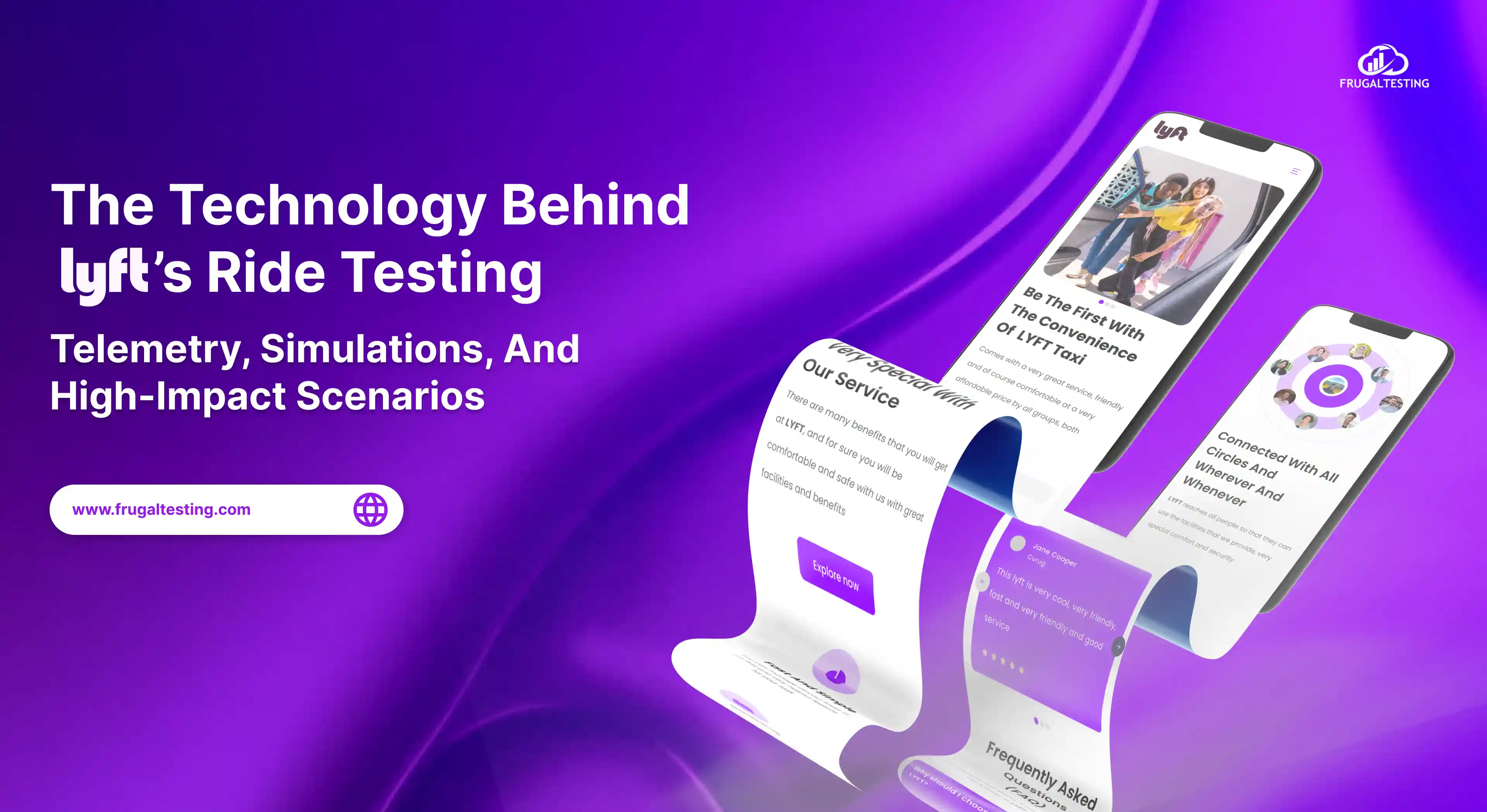E-commerce websites must be prepared for high traffic spikes that can lead to slow response times, failed transactions, and lost revenue. Cloud testing offers a scalable way to simulate peak loads in dynamic cloud environments, helping prevent revenue loss and protect customer trust.
Through scalability testing, businesses can ensure their platforms auto-scale using virtual machines, while endurance testing verifies stability over extended high-traffic periods. Add to that security testing to safeguard user data, and you create a fast, secure, and resilient user experience. With the right strategy, cloud testing enables e-commerce platforms to stay responsive, reliable, and profitable even during extreme demand.
💡 Here’s what you’ll learn:
📌 How cloud performance testing boosts response times and user experience.
📌 Role of auto-scaling, CDNs, and caching in e-commerce scalability.
📌 Why endurance and security testing prevent downtime and revenue loss.
📌 Using cloud environments and virtual machines for scalable testing.
📌 Integrating test automation and DevOps for continuous performance.
What Is Cloud Performance Testing?
Cloud performance testing assesses how apps run in a cloud environment under typical and high workload conditions. Unlike traditional performance testing, which runs tests on fixed on‑premise hardware, cloud performance testing leverages the elasticity of cloud infrastructure to simulate real‑world traffic patterns at scale. It combines software performance testing, load testing, and cloud application performance monitoring to ensure your e‑commerce platform can handle spikes without downtime.
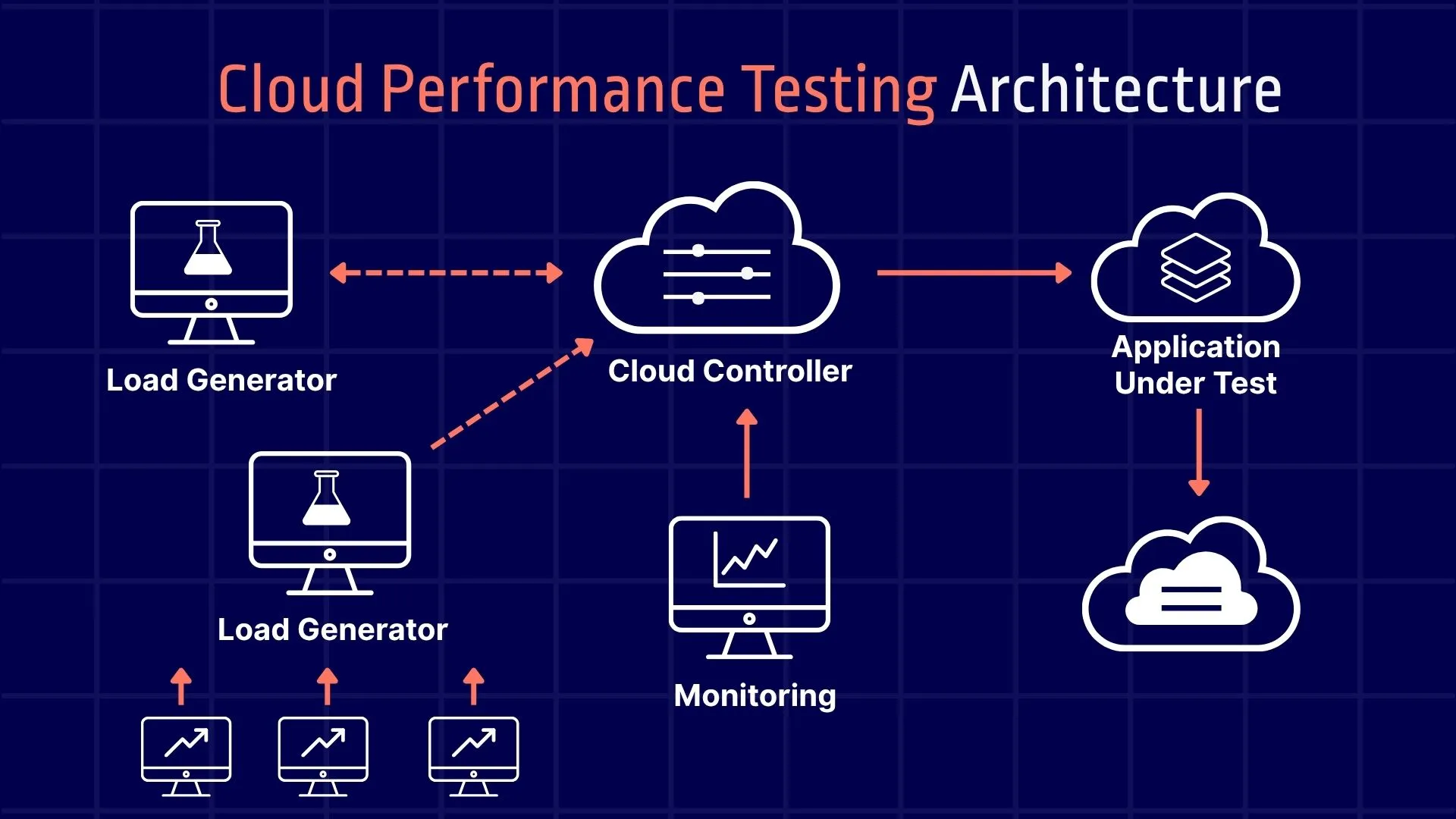
Key Practices in Cloud Performance Testing:
- On-Demand Load Generation: Use tools like JMeter, Gatling, or k6 to simulate high user loads without dedicated hardware.
- Auto-Scaling Validation: Test if services like AWS Auto Scaling automatically add resources to maintain performance.
- Real-Time Monitoring: Track CPU, memory, network, and database usage using cloud monitoring tools.
- Cost Optimization: Control costs by aligning performance needs with pay-as-you-go cloud pricing.
By adopting cloud performance testing, e‑commerce teams gain confidence that their website and back‑end services will remain fast and reliable whether during routine traffic or flash‑sale peak loads.
Introduction to Cloud Performance Testing for E-Commerce
Cloud performance testing for e-commerce platforms is essential to ensure seamless shopping experiences, especially during peak traffic events like flash sales, product launches, or festive seasons. With the dynamic nature of online retail, where user expectations are high and downtime is unacceptable, businesses must validate how their applications perform under varying loads across cloud based infrastructure.
Cloud performance testing simulates real-world user behavior using cloud-based tools and resources to measure how websites, APIs, and applications respond to traffic spikes. This approach goes beyond traditional testing by leveraging high performance cloud computing, auto scaling, and cloud application performance monitoring to ensure both speed and stability.
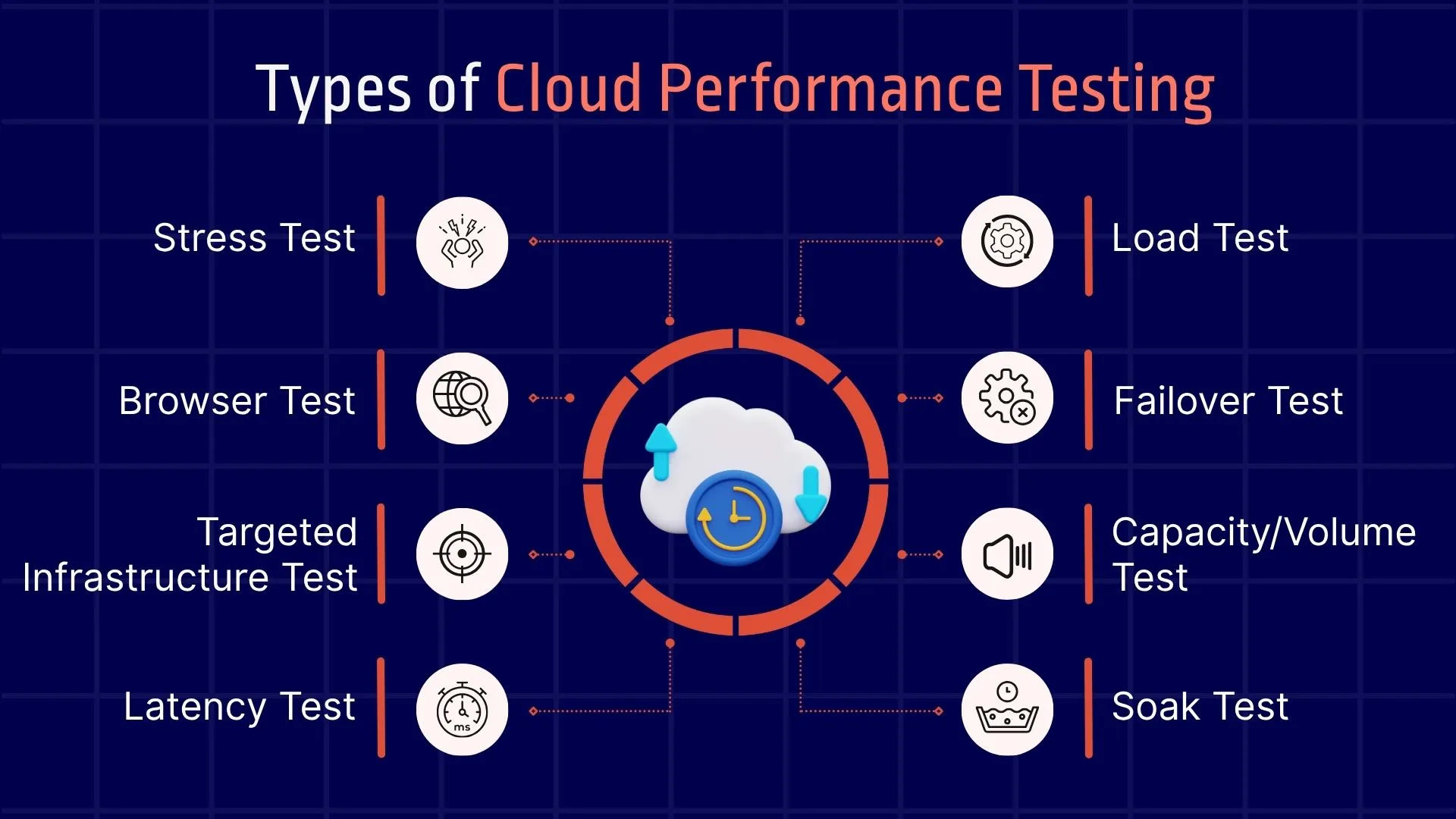
Cloud-based testing enables e-commerce businesses to maintain consistent performance, reduce cart abandonment, and protect brand credibility. With automated CI/CD pipelines, they can continuously test and stay prepared for any traffic surge from 1,000 to 1 million users.
Why E-Commerce Platforms Need Cloud-Based Load Testing
E-commerce platforms operate in a high-stakes environment where traffic surges can happen unpredictably from holiday sales to influencer promotions. Cloud-based load testing empowers businesses to prepare for such scenarios by simulating real-world user loads on their applications, ensuring both scalability and resilience. Unlike traditional testing approaches, cloud load testing tools offer flexibility, global scalability, and faster feedback cycles critical for delivering seamless customer experiences.
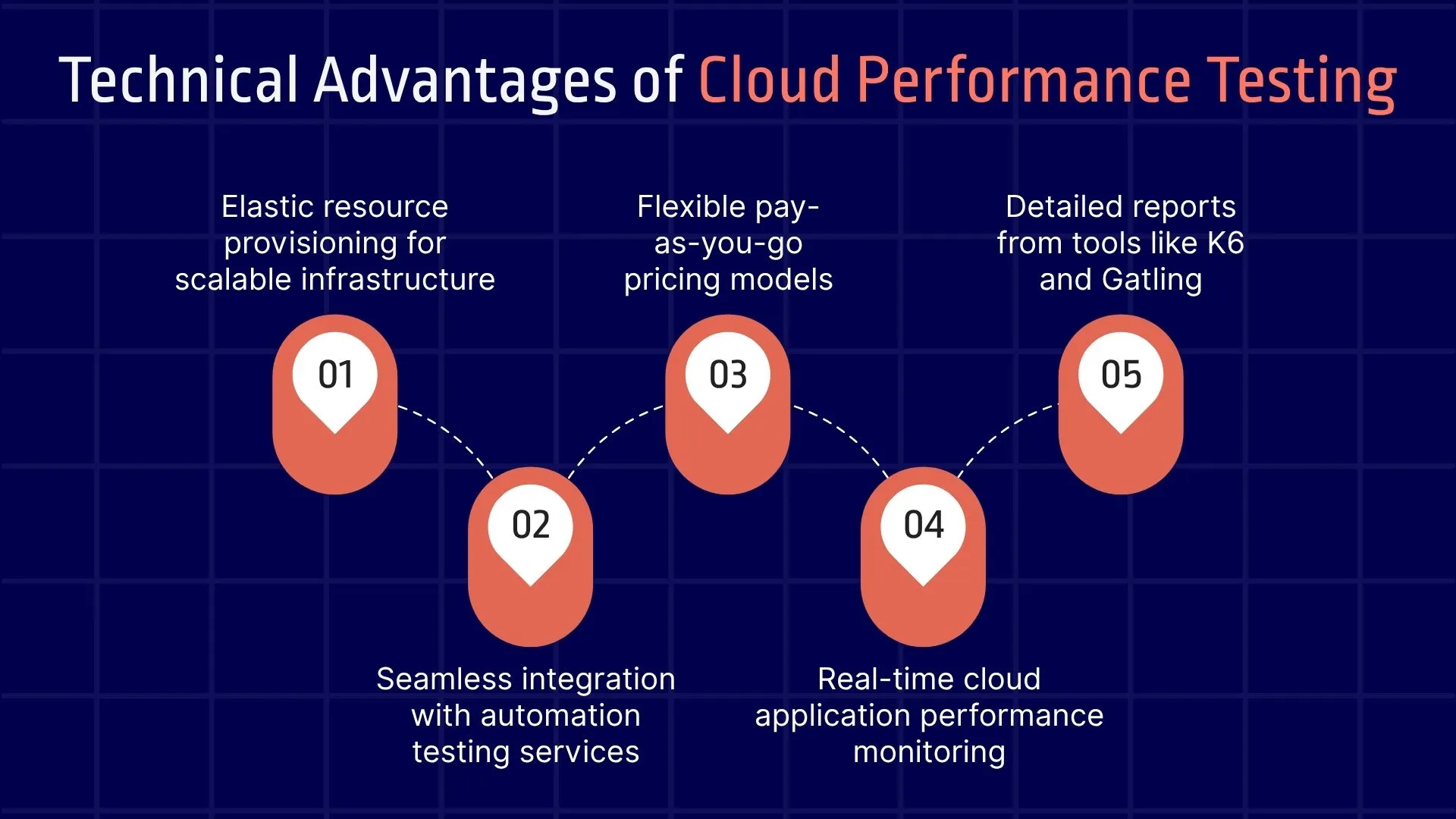
Why Cloud-Based Load Testing Is Essential for E-Commerce:
- Simulates Real-World Traffic: Emulates thousands to millions of users using tools like JMeter, Locust load testing, or Azure Load Testing.
- Validates Auto Scaling: Tests how well your infrastructure scales with demand on AWS or Oracle Cloud.
- Speeds Up Releases: Automates load testing in CI/CD pipelines to accelerate time-to-market.
- Detects Bottlenecks Early: Identifies slow APIs, overloaded databases, and UI issues.
- Enables Global Testing: Launches tests from multiple regions to measure latency and cross-browser performance.
- Prevents Downtime: Finds and fixes performance issues before they affect users or sales.
Key Challenges During Peak Traffic in E-Commerce
Handling peak traffic in e-commerce is critical yet complex. Sudden surges in user activity during flash sales, holiday rushes, or unexpected viral moments can strain infrastructure, causing slowdowns or outages. Cloud performance testing helps identify these bottlenecks, but understanding the key challenges is vital for effective preparation.

Effective handling of these challenges through cloud performance testing ensures seamless, secure, and scalable e-commerce experiences during peak traffic.
Flash Sales, Holiday Rush, and Sudden Spike Scenarios
During flash sales or holiday seasons, e-commerce platforms experience unpredictable, intense bursts of traffic.
- Flash Sales:
Limited-time deals cause massive simultaneous checkouts, requiring ultra-fast transaction processing and resilient load balancing. - Holiday Rush:
Extended high traffic over days demands sustained performance, continuous auto scaling, and constant monitoring of performance metrics like throughput and latency. - Sudden Spikes:
Viral marketing or social media can trigger unexpected traffic. Real-time cloud application performance monitoring and rapid incident response are crucial.
This visual will help readers quickly grasp the multifaceted challenges of peak e-commerce traffic.
Performance Metrics That Matter for E-Commerce
A smooth shopping experience depends on keeping an eye on important performance indicators including response time, throughput, and mistake rates. These cloud-based performance indicators help optimize speed, reliability, and scalability during high-traffic events.
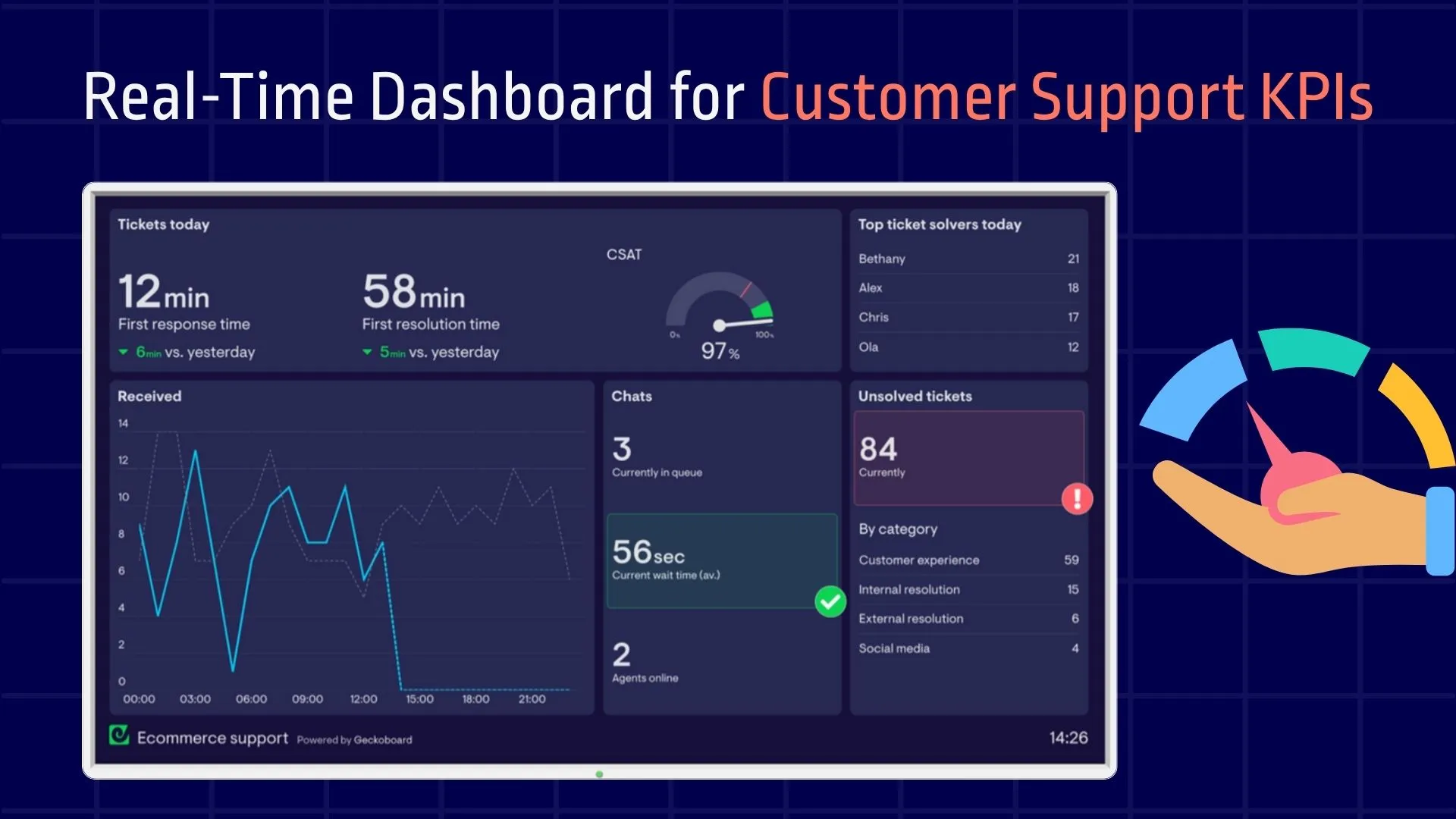
Effective cloud performance testing focuses on key performance metrics (KPIs) critical for e-commerce success:
- Response time: Time taken to load pages or complete transactions.
- Throughput: Number of transactions processed per second.
- Error rate: Percentage of failed requests under load.
- Resource utilization: CPU, memory, and network bandwidth of cloud infrastructure.
- Scalability: Ability to maintain performance as load increases.
Tracking these key performance indicators KPIs enables continuous improvement and ensures a smooth shopping experience even at peak times.
Strategies to Handle Peak Traffic Using Cloud Testing
Handling peak traffic efficiently in e-commerce requires a strategic approach combining cloud performance testing, scalable infrastructure, and real-time monitoring. With cloud testing, you can proactively prepare your platform for high-load conditions, reducing the risk of downtime and improving customer experience.

Key Strategies for Managing Peak Traffic:
- Auto-Scaling with Load Testing: Use tools like JMeter and Gatling to simulate peak loads and validate auto-scaling (AWS, Azure).
- Early Bottleneck Detection: Identify API, database, and front-end issues with performance testing and monitoring.
- Real-Time Cloud Monitoring: Track KPIs such as latency, response time, and errors with live dashboards.
- Geographic Load Distribution: Spread traffic across cloud regions (AWS, GCP, Oracle) to reduce latency.
- Performance Automation in CI/CD: Integrate performance tests into DevOps pipelines for deployment readiness.
- Leverage Caching and CDNs: Cache static content and use CDNs to reduce server load.
- Pre-Sale Stress Testing: Conduct stress and soak tests before major campaigns to ensure resilience.
Choosing the Right Cloud-Based Performance Testing Tools
Selecting the right cloud-based performance testing tools is essential for building scalable, resilient e commerce software platforms. These tools help simulate user load, monitor application behavior, and identify bottlenecks across cloud environments. The choice of tool depends on your testing goals whether it's stress testing APIs, validating mobile responsiveness, or running large-scale distributed load tests.
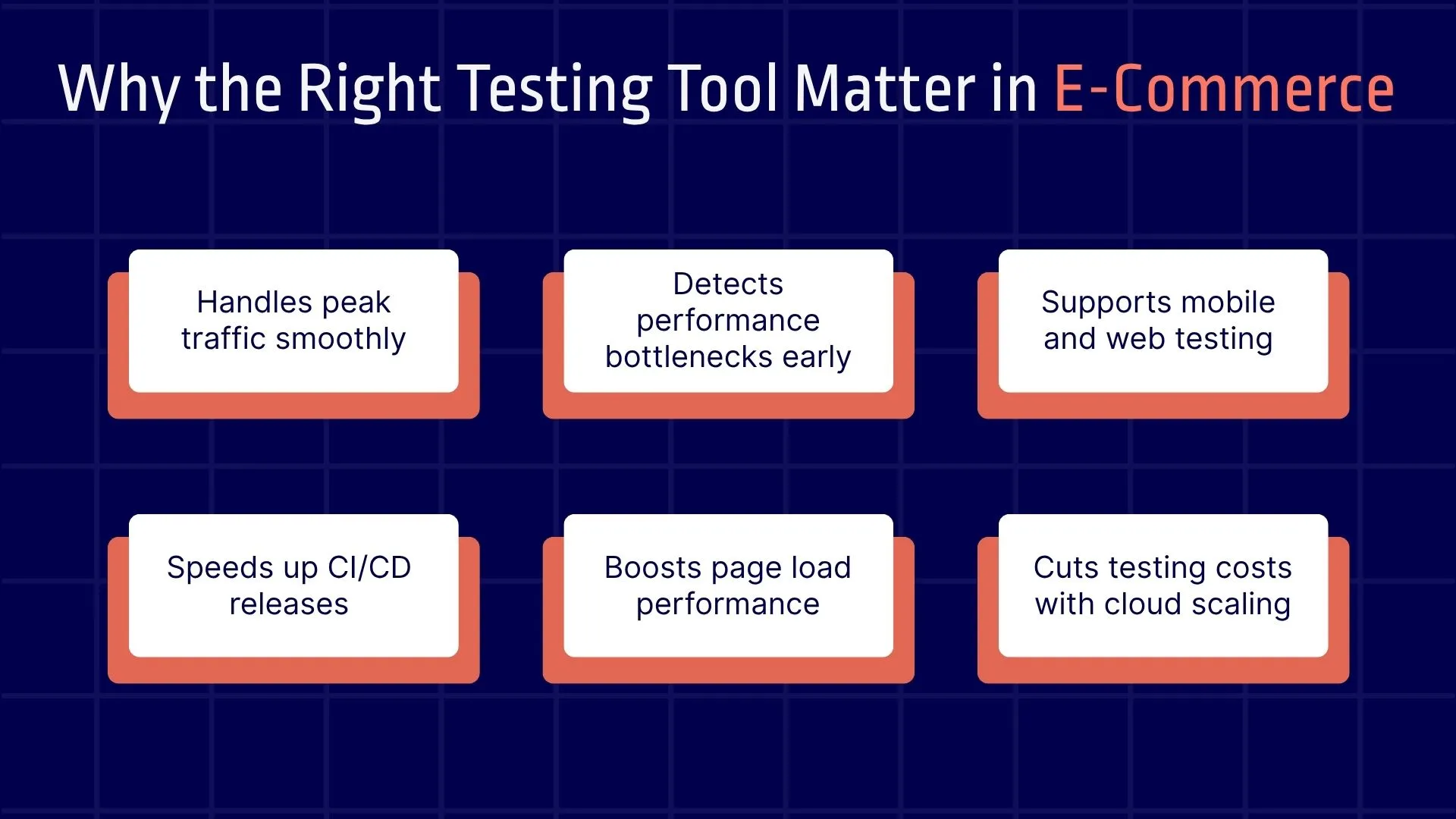
What to Look for in a Cloud-Based Testing Tool:
- Scalability: Ability to simulate thousands or millions of users with cloud infrastructure and services.
- Protocol Support: Must support web performance testing, API load testing, and mobile-friendly test scenarios.
- Integration Capability: Easy CI/CD pipeline integration with tools like Jenkins, Azure DevOps, and GitLab.
- Reporting & KPIs: Detailed reports on performance metrics like response time, throughput, and error rate.
- Ease of Use & Automation: Tools should support automation testing services with minimal setup, especially for teams with limited DevOps capacity.
- Cost Efficiency: Consider tools that offer pay-per-use pricing models to align with your cost optimization goals.
Top Tools: JMeter, BlazeMeter, Gatling, LoadNinja
Choosing the right cloud-based performance testing tool can make or break your e-commerce testing strategy. Below are four popular tools, each offering unique strengths for load testing, API testing, and cloud performance testing.
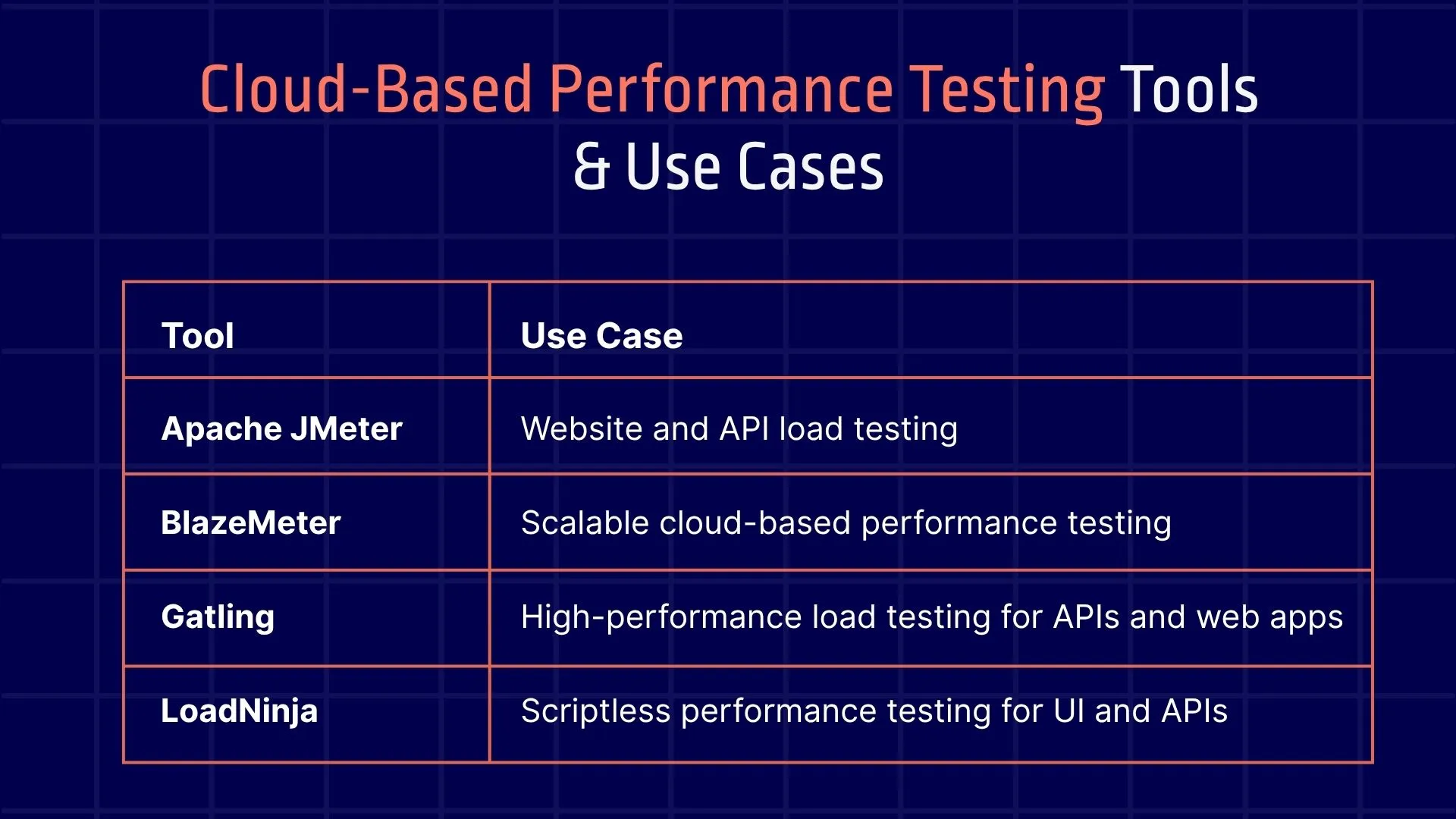
- Apache JMeter:
- Open-source and extensible
- Supports performance and functional testing
- Compatible with BlazeMeter for cloud execution
- Best for teams looking for customizable, script-driven test plans
- BlazeMeter:
- Built on top of JMeter, Selenium, and Gatling
- Cloud execution with real-time reporting dashboards
- CI/CD integration with Jenkins, Azure DevOps, etc.
- Best for enterprise teams needing cloud load testing tools with automation
- Gatling:
- Lightweight, developer-friendly DSL
- Integrates with CI/CD pipelines
- Offers both open-source and enterprise cloud options
- Best for agile teams that value speed, automation, and code-based testing
- LoadNinja:
- Record and playback-based test creation
- Real browser testing with performance metrics
- Real-time debugging and analytics
- Best For QA teams looking for fast setup without heavy scripting
Simulating User Journeys During Load Tests
Simulating realistic user journeys during load tests is crucial for understanding how your e-commerce application performs under real-world conditions. Rather than testing isolated endpoints, user journey simulations evaluate full workflows such as browsing products, adding items to cart, and completing checkout under heavy load, ensuring both functionality and performance hold up at scale.
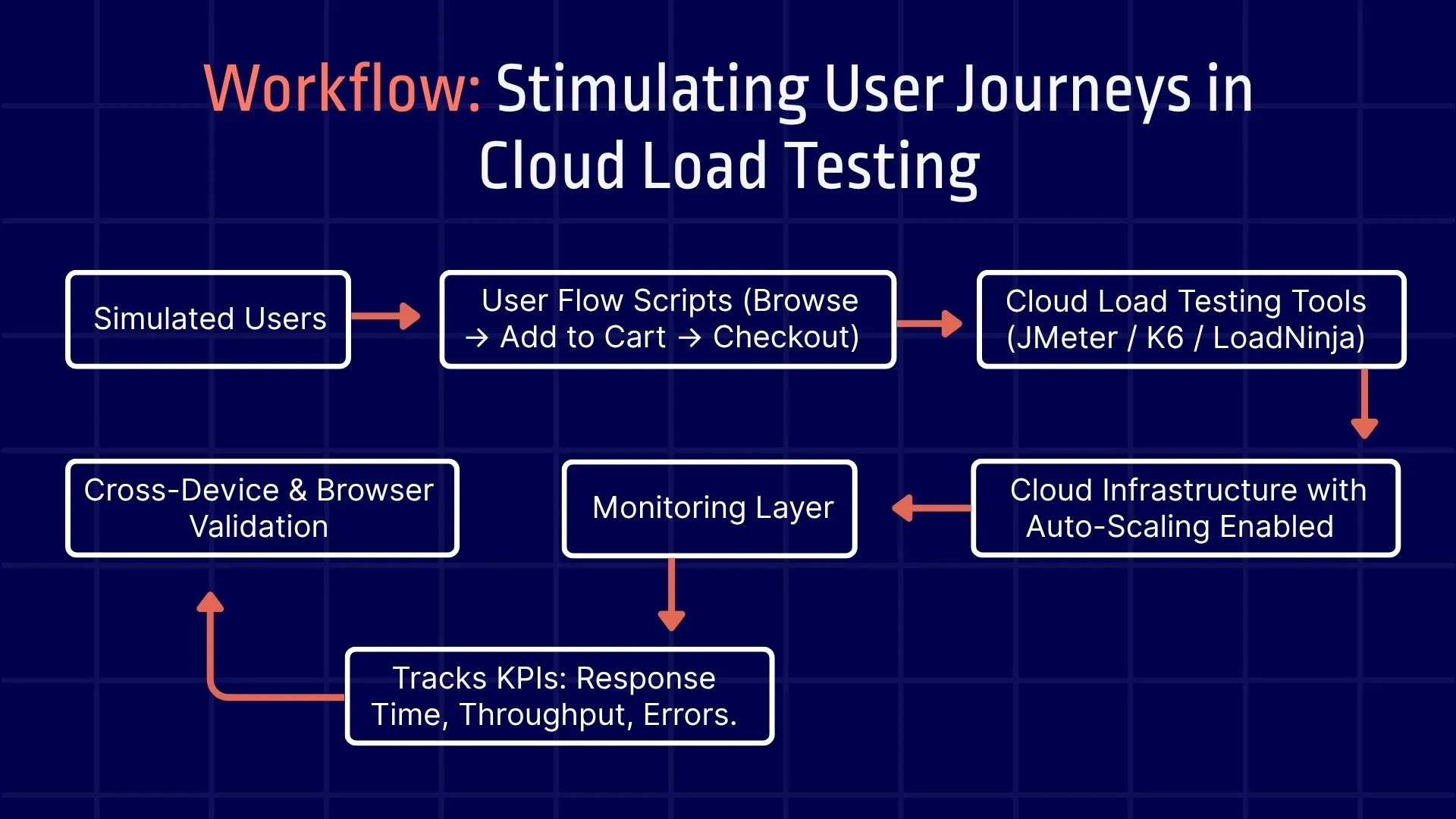
How to Implement Journey Simulations:
- Use tools like JMeter, LoadNinja, or K6 to script real user flows.
- Include APIs, UI interactions, and third-party service calls (e.g., payment gateways).
- Monitor application performance testing KPIs such as response time, session duration, and throughput.
- Run simulations in cloud infrastructure environments with auto scaling enabled to validate responsiveness under traffic spikes.
Optimizing Cloud Infrastructure for Peak Traffic
To ensure e-commerce platforms can handle massive traffic surges, it’s essential to optimize your cloud infrastructure services. This includes ensuring fast content delivery, efficient resource scaling, and seamless user experience even during high-load scenarios.
Leveraging auto-scaling, global CDNs, and load balancers helps maintain uptime and performance. Continuous cloud performance testing ensures your infrastructure remains resilient under peak traffic conditions.
Auto-Scaling, CDN, and Caching Techniques
To ensure high availability and fast performance during peak traffic, e-commerce platforms must leverage smart infrastructure strategies. Auto-scaling, CDNs, and caching play a crucial role in optimizing speed, reliability, and user experience.
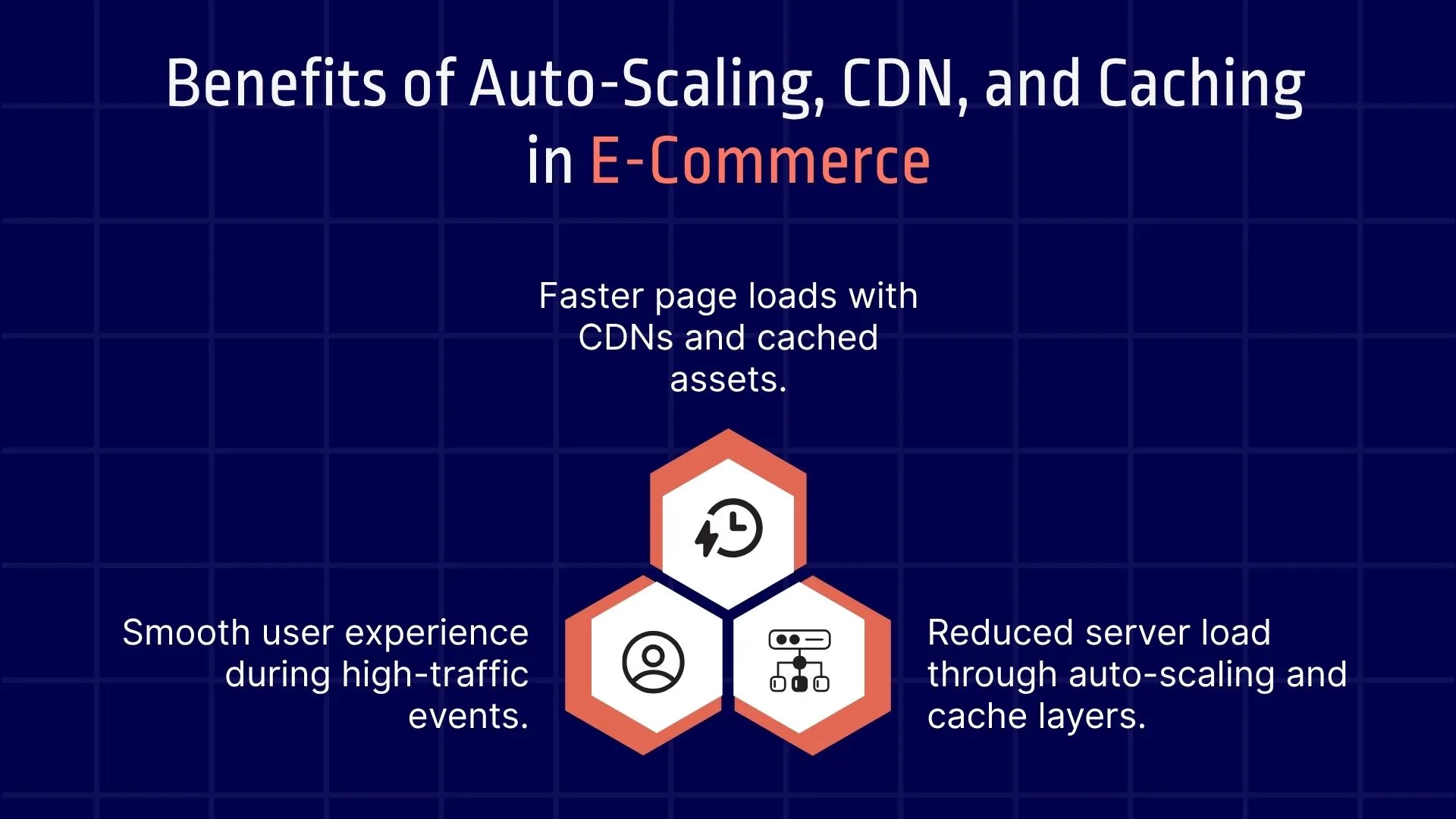
Handling high traffic in e-commerce requires a fast, flexible infrastructure:
- Auto-Scaling:
Tools like AWS Auto Scaling, Azure VM Scale Sets, and Google Cloud autoscaler adjust resources in real time, keeping your cloud-native applications responsive under peak loads. - CDN (Content Delivery Network):
CDNs like Cloudflare and Akamai deliver content closer to users, improving load times across varying internet speeds and device capabilities. - Caching Techniques:
Solutions like Redis, Varnish, and CloudFront cache frequently accessed data, boosting API response times and reducing server strain.
These techniques are vital for maintaining fast, reliable performance in hybrid cloud environments with microservices architecture.
Mobile E-Commerce Performance Testing
Mobile users account for over 70% of e-commerce traffic. Ensuring fast, responsive mobile experiences through cloud performance testing is vital for conversions and retention.
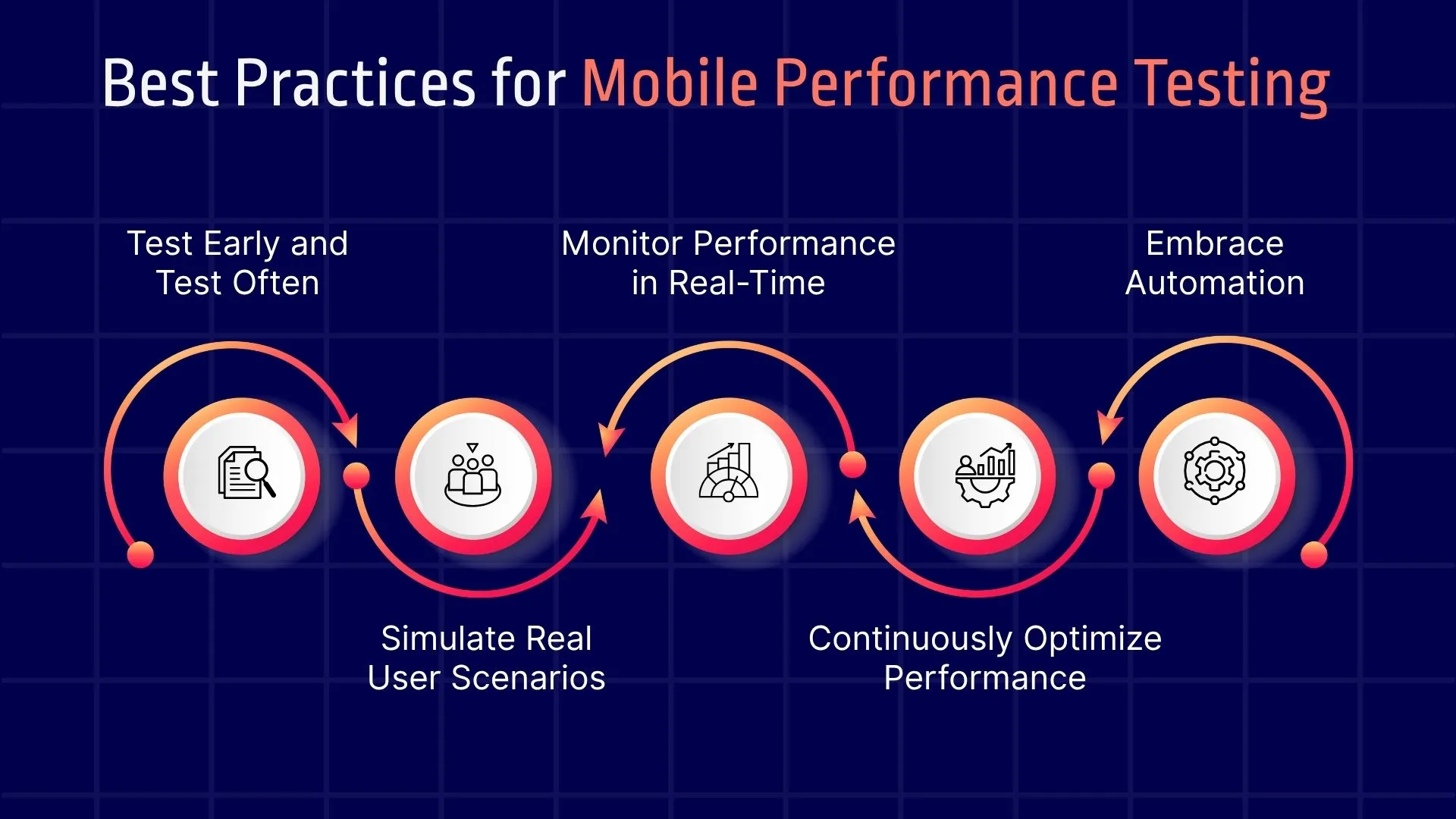
Testing Across Devices, Networks, and Browsers
Delivering a seamless e-commerce experience requires rigorous testing across various devices, browsers, and network conditions. Cloud testing platforms make it possible to replicate real-world scenarios at scale.
- Device Variability:
Run tests across a range of screen sizes, operating systems, and hardware specs using cloud-based mobile testing platforms. - Network Conditions:
Simulate different network types (2G, 3G, 4G, 5G, Wi-Fi) to evaluate mobile responsiveness in real-world environments. - Cross-Browser Testing:
Use cross browser testing cloud tools like BrowserStack or Sauce Labs to ensure consistent behavior across Chrome, Safari, Firefox, etc. - Mobile App Security Testing:
Incorporate security testing and cloud penetration testing to protect sensitive mobile transactions and user data.
Ensuring compatibility and performance across all touchpoints helps boost engagement, reduce bounce rates, and protect your e-commerce solutions platform from failures and vulnerabilities.
Cost Optimization in Cloud Performance Testing
While cloud testing enables scalability and faster deployments, uncontrolled usage can quickly inflate costs. It's crucial to optimize testing frequency, test environments, and resource consumption to maintain budget efficiency.
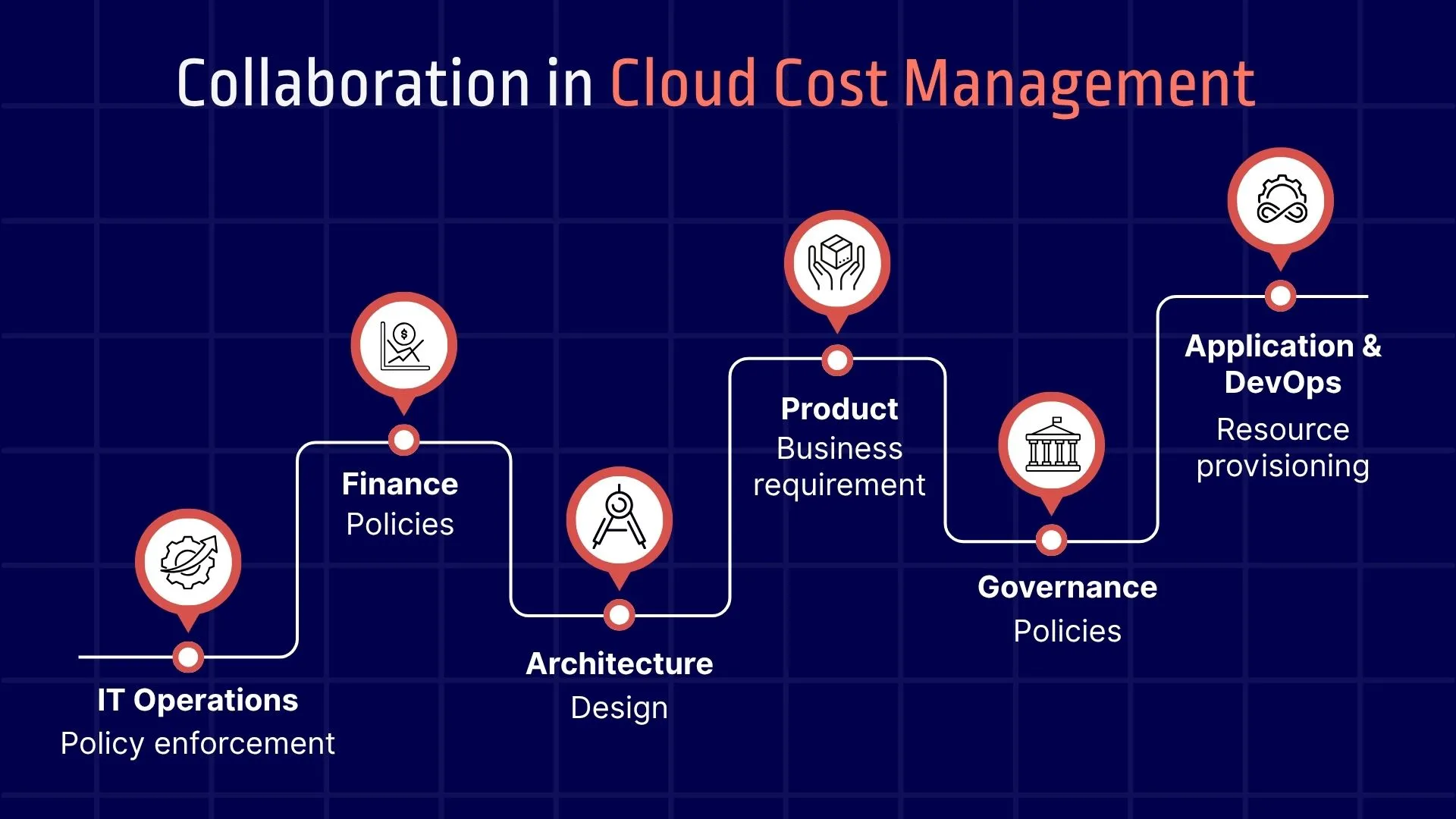
Proactively tracking cloud costs ensures better ROI from your performance testing efforts. Leveraging cloud cost management tools helps teams scale wisely without overspending.
Managing Resource Usage During Test Execution
Efficient resource management is key to reducing costs and maximizing ROI during cloud performance testing. By carefully controlling how and when resources are used, e-commerce teams can maintain high test coverage without unnecessary cloud spend.
- On-Demand Resource Allocation: Only provision cloud resources (VMs, load generators, etc.) when tests are running to avoid idle costs.
- Use Open Source Tools: Adopt tools like JMeter performance testing, Locust, or k6 performance testing to avoid high licensing fees.
- Auto Termination Policies: Set scripts to tear down test environments immediately after execution.
- Monitor Billing Metrics: Use cloud provider cost dashboards to track performance testing expenses and align them with traffic simulation intensity.
- Prioritize Business-Critical Journeys: Focus heavy-load simulations on high-revenue paths like search, checkout, and payment saving resources by excluding less critical paths.
Strategic test planning and smart cloud resource allocation not only control costs but also ensure peak performance during real-world traffic spikes.
Conclusion: Delivering Seamless Shopping Experiences at Scale
Cloud performance testing is no longer optional; it's a necessity for modern e-commerce. By leveraging cloud infrastructure, performance testing tools, and load testing frameworks, businesses can ensure their digital storefronts stay fast, secure, and reliable regardless of traffic volume.
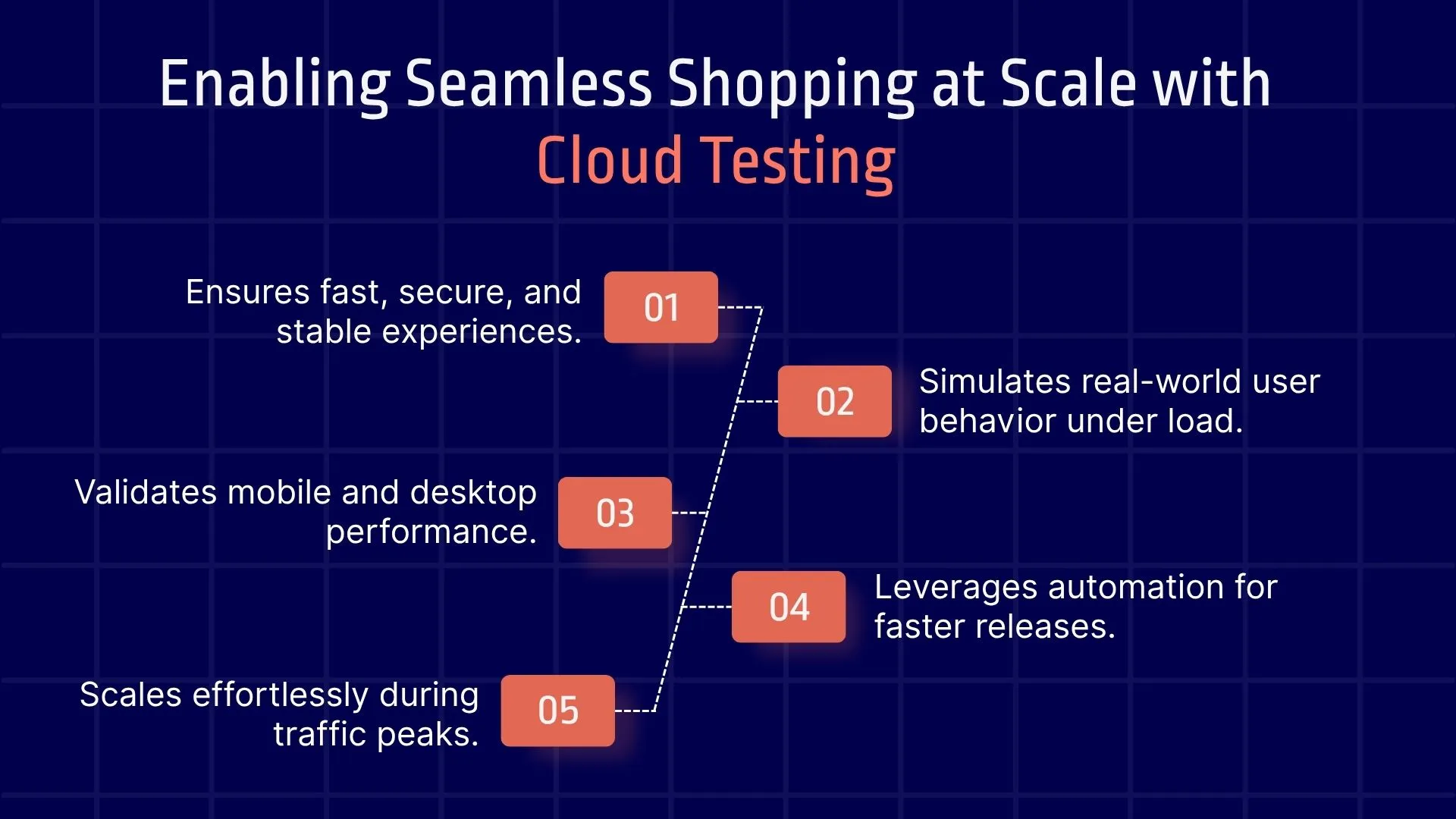
To succeed, e-commerce platforms must:
- Simulate real-world user behavior
- Monitor performance KPIs continuously
- Use automation and scalability features smartly
- Optimize for cost without compromising quality
- Test mobile and desktop experiences alike
By applying these strategies, your e-commerce brand can handle peak demand confidently delivering a seamless and satisfying customer experience at any scale.
People Also Ask
👉 How can cloud performance testing improve customer retention in e-commerce?
Cloud performance testing ensures fast, reliable shopping experiences during peak traffic, reducing bounce rates and boosting customer satisfaction. A smooth, responsive site encourages repeat visits and long-term loyalty.
👉 What role does geographic load distribution play in e-commerce performance testing?
Geographic load distribution tests how your platform performs across regions, ensuring low latency and consistent speed for global users. It helps optimize content delivery using CDNs and localized servers.
👉 How do cloud testing platforms ensure data privacy during performance tests?
Cloud testing platforms follow strict security protocols, including data encryption and role-based access control, to safeguard sensitive information. Compliance with GDPR and other regulations is often built-in.
👉 What’s the impact of third-party APIs on e-commerce performance under load?
Third-party APIs can introduce latency or failures during high traffic, affecting cart, payment, and shipping flows. Cloud performance testing identifies these bottlenecks before they impact users.
👉 How does AI enhance performance testing in modern e-commerce platforms?
AI-driven testing tools analyze performance trends, predict failures, and optimize test coverage. This ensures faster issue resolution and smarter resource scaling during peak e-commerce activity.



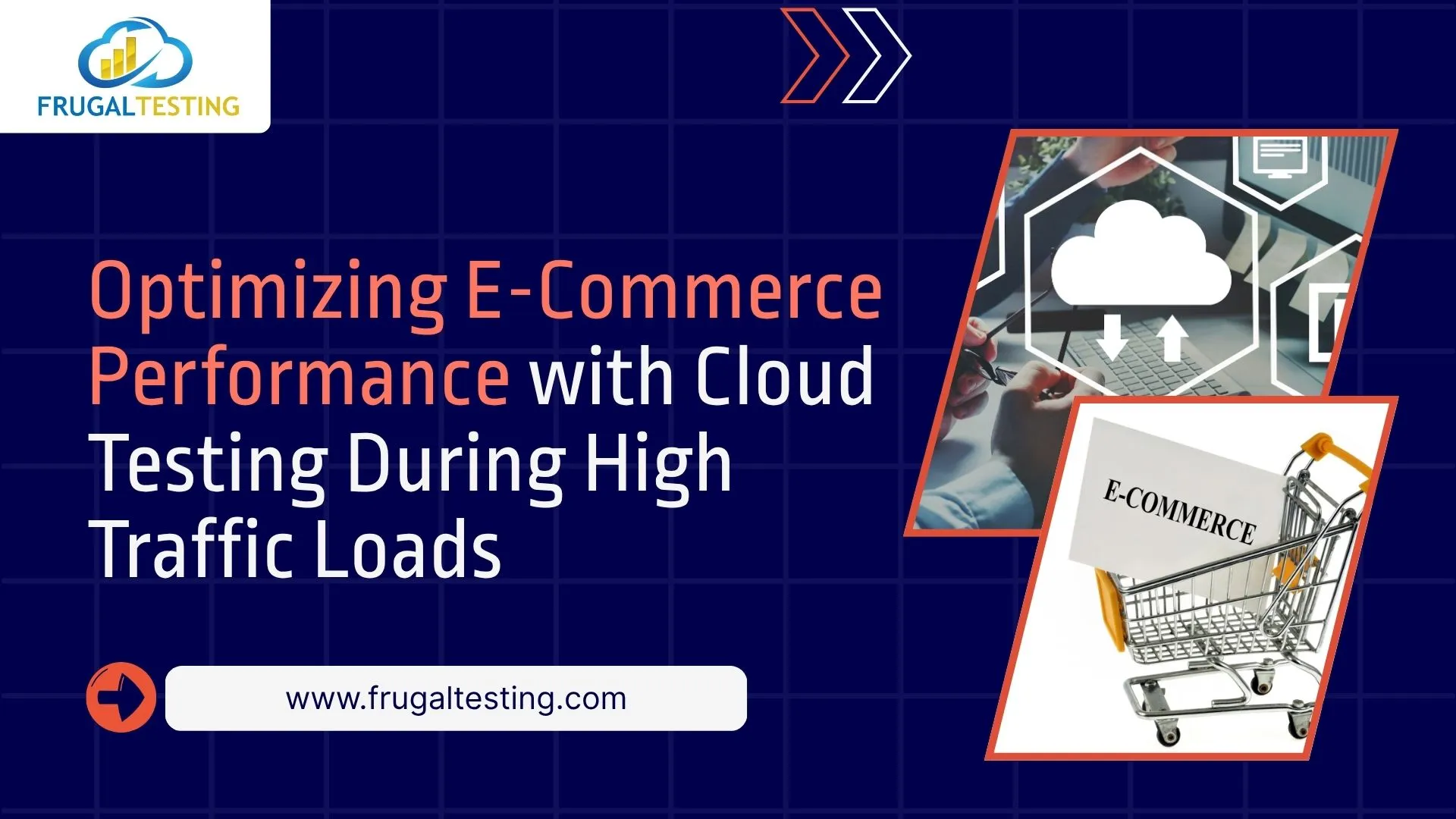

%201.webp)
